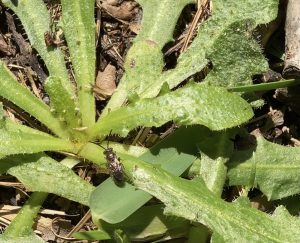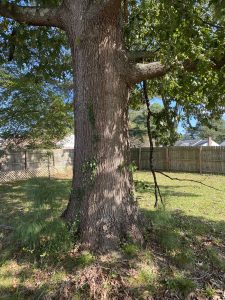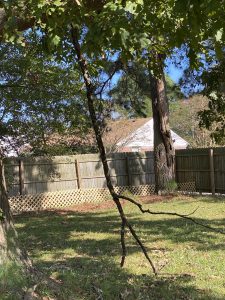At the start of my 15 minutes of focus at my sit spot location, it was very gloomy. There was an overcast which made the area gray and a strong breeze that blew in from my north. The temperature was around the low 70s, but the wind made it colder. I noticed during my focus time how these cooler temperatures were affecting my sit-spot environment. One of my first observations was that the ants who resided in the sit-spot were nowhere to found. I mean, I am surprised that three weeks made that much of a difference. Theses ants went from crawling up the chair and taking a stroll up to my arm to being nowhere in sight. Oh, I can tell you what was in sight, A BIG HUGE BEE! and that he was way more interested in me than I was in him. I tried to play to cool, but with every second he inched closer to my face, panic began to rise within me. My fight or flight kicked into gear; I ran away as fast as I possibly could. I want to learn more about why the ants had vanished, but insects like bees, wasps, and flies were still out and about. What environmental change caused them to leave, or what variation do these different insects have that allow some of them to be comfortable in these colder temperatures and others not. I also noticed that there were a lot more leaves on the ground then there was before. This made sense since we are currently progressing into fall, leaves are not producing chlorophyll and are instead using carotenoids before eventually making their way to the ground.


Another item that I noticed on the ground was a decaying mushroom. It was a decent size, rounded brown top (shaped like an upside-down letter U) with an all-white stem. The tip of the mushroom cap was white and crusty like it was moldy or rotten. I didn’t get close enough to sniff it, but it was in rough shape.Circulating this decaying mushroom was what looked to be baby flies. I don’t think they were full-grown adult flies because their overall size was small, but I’m also just taking a guess. I watched the flies for a while; they would land on the mushroom, grass around the mushroom, and even my foot.
In one clip I think I caught the flies reproducing(haha), but I’m not sure. fullsizeoutput_5e42 It was about five of these flies and one other insect, but I don’t know the exact name of that other insect. I started to wonder what was attracting these flies to this location. Could it have been the decaying mushroom? or was it something I couldn’t see with a naked eye? I would love to go back to the sit-spot location to see if flies are still in that area or if they dispersed. If the flies did leave, would the mushroom still be there? Would it be gone? These are all the questions that are running through my mind. fullsizeoutput_5e3f (video clip of flies)


When discussing how water plays a role in my sit-spot location, I did have a tough time organizing my thoughts. I decided to start by observing the ground. What the dirt felt like, how firm was it, and how the grass above it looked? For starters, I stomped on the ground; it was hard and firm. When I felt the dirt it was dry, but crumbly sand-like dry. I am guessing I could describe it as; almost at its last stage of being completely unsaturated at the surface level. Maybe, I was feeling the coldness of the dirt. The moss above the dirt had many more brown patches of moss than last time I visited the sit-spot. The grass that fell under the tree in the shaded region had dry tan dead grass at the bottom, but it was still green on top. I was assuming that this had something to do with lack of water because if they had a full abundance of water available there, wouldn’t be dead grass or brown moss insight. The water in the ground could even be beginning to freeze (Maybe?) I’m not quite sure, but this is something I want to investigate more.
In conclusion, this sit-spot experience was enlightening and left me with a lot of questions. Being able to compare and track changes in the environment brought about the opportunity to focus on what is causing or bringing about change. This ultimately allows me to interpret concepts we have learned in lectures and apply them to my sit-spot thinking. Also, I would just like to add in the species of my tree it is a Cherrybark Oak Tree (Quercus pagoda) and it is native to Virginia.
Here is a quick update on the tree after a late-night storm (with high winds)it lost a branch.



You sit spot sounds really nice! And bees terrify me too especially because I was stung by one in fourth grade. So if I was in your situation I would run away too.
I’ve never been stung by a bee before, but the fear of being stung is what keeps me running away as fast as I can lol!
Probably that bee was a HER not a HIM….interesting how we always gender male but particularly in hymenoptera nearly everyone we see is female.
I also like how you physically interacted with your space – stomped on the ground – what does the soil feel like – think about field capacity and wilting point ….does that relate.
good work zoe
Yes, misgendering insects is a very bad habit of mine that I have to break ( I don’t know why I subconsciously think they are male), but thank you for correcting me and teaching me something new. The more you know the more you grow! 🙂
I can picture your interaction with ants and bees just with your description. I had a tough time deducing the role of water too–I did the same, observed the ground! I look forward to reading updates on your sit-spot in the coming weeks. 🙂
Thank you! That’s so cool that we thought of the same strategy for finding the role of water in our spots, great minds definitely do think alike! 🙂